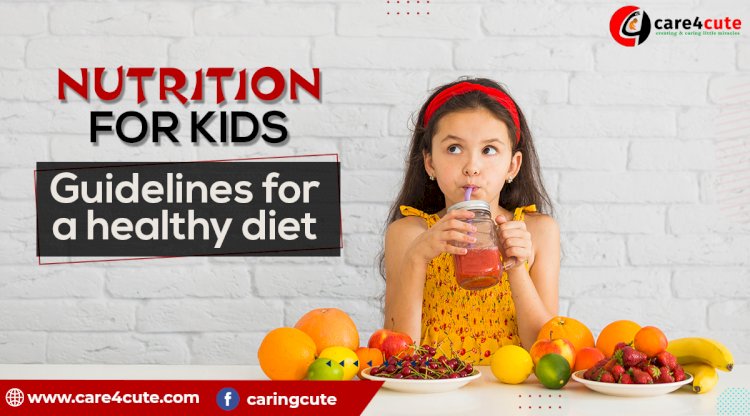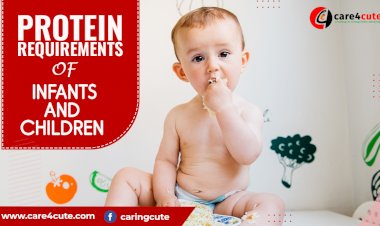Nutrition for kids: Guidelines for a healthy diet
As new parents, we are all aware of the importance of good nutrition as a child goes from infancy to adolescence. Learn the value of Nutrition for kids along with Guidelines for a healthy diet

Having a healthy diet and following a healthy routine is good for every person on this planet, especially growing children. Almost every family today has busy schedules, which makes it hard to sit down with all the family members to have homemade meals together every day. As a result, most of the children’s diets involve a lot of convenience and takeout food. But most of the time these foods are unhealthy and not containing all the required nutrition. So, they can have a negative effect on a child’s health. Some of the problems caused by following unhealthy eating routines can be continued into adulthood. They can even develop into lifelong diseases.
Healthful eating has many benefits for children. It can:
- Stabilize their energy.
- Improve their minds.
- Improve your moods.
- Help in remaining fit and healthy
- Help them maintain a healthy weight.
- Help prevent mental health conditions like anxiety, depression, etc.
- Help in preventing diseases.
The following can also be major signs that your child is developing malnutrition.
1. Change in the balance of electrolytes in the blood.
2. Changes in behavior, being slow, usually irritable, and moody.
3. Developing infections frequently due to a poor immune system.
4. Reduced muscle mass.
5. Bruising and broken bones.
6. Tiredness, slow movements.
7. Low intellectual skills.
|
Ages 2 to 4: Daily guidelines for girls |
|
|
Calories |
1,000-1,400, depending on growth and activity level |
|
Protein |
2-4 ounces |
|
Fruits |
1-1.5 cups |
|
Vegetables |
1-1.5 cups |
|
Grains |
3-5 ounces |
|
Dairy |
2-2.5 cups |
|
Ages 2 to 4: Daily guidelines for boys |
|
|
Calories |
1,000-1,600, depending on growth and activity level |
|
Protein |
2-5 ounces |
|
Fruits |
1-1.5 cups |
|
Vegetables |
1-2 cups |
|
Grains |
3-5 ounces |
|
Dairy |
2-2.5 cups |
|
Ages 5 to 8: Daily guidelines for girls |
|
|
Calories |
1,200-1,800, depending on growth and activity level |
|
Protein |
3-5 ounces |
|
Fruits |
1-1.5 cups |
|
Vegetables |
1.5-2.5 cups |
|
Grains |
4-6 ounces |
|
Dairy |
2.5 cups |
|
Ages 5 to 8: Daily guidelines for boys |
|
|
Calories |
1,200-2,000, depending on growth and activity level |
|
Protein |
3-5.5 ounces |
|
Fruits |
1-2 cups |
|
Vegetables |
1.5-2.5 cups |
|
Grains |
4-6 ounces |
|
Dairy |
2.5 cups |
|
Ages 9 to 13: Daily guidelines for girls |
|
|
Calories |
1,400-2,200, depending on growth and activity level |
|
Protein |
4-6 ounces |
|
Fruits |
1.5-2 cups |
|
Vegetables |
1.5-3 cups |
|
Grains |
5-7 ounces |
|
Dairy |
3 cups |
|
Ages 9 to 13: Daily guidelines for boys |
|
|
Calories |
1,600-2,600, depending on growth and activity level |
|
Protein |
5-6.5 ounces |
|
Fruits |
1.5-2 cups |
|
Vegetables |
2-3.5 cups |
|
Grains |
5-9 ounces |
|
Dairy |
3 cups |
|
Ages 14 to 18: Daily guidelines for girls |
|
|
Calories |
1,800-2,400, depending on growth and activity level |
|
Protein |
5-6.5 ounces |
|
Fruits |
1.5-2 cups |
|
Vegetables |
2.5-3 cups |
|
Grains |
6-8 ounces |
|
Dairy |
3 cups |
|
Ages 14 to 18: Daily guidelines for boys |
|
|
Calories |
2,000-3,200, depending on growth and activity level |
|
Protein |
5.5-7 ounces |
|
Fruits |
2-2.5 cups |
|
Vegetables |
2.5-4 cups |
|
Grains |
6-10 ounces |
|
Dairy |
3 cups |

 Admin
Admin 

































Comments (0)